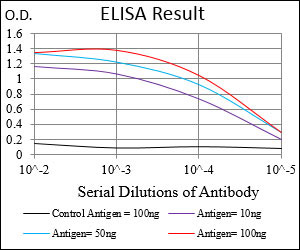MuRF1 Antibody
Purified Mouse Monoclonal Antibody
- 产品详情
- 实验流程
- 背景知识
Application
| IHC, E |
|---|---|
| Primary Accession | Q969Q1 |
| Reactivity | Human |
| Host | Mouse |
| Clonality | Monoclonal |
| Clone Names | 6H6D4 |
| Isotype | IgG1 |
| Calculated MW | 40248 Da |
| Description | This gene encodes a member of the RING zinc finger protein family found in striated muscle and iris. The product of this gene is an E3 ubiquitin ligase that localizes to the Z-line and M-line lattices of myofibrils. This protein plays an important role in the atrophy of skeletal and cardiac muscle and is required for the degradation of myosin heavy chain proteins, myosin light chain, myosin binding protein, and for muscle-type creatine kinase. |
| Immunogen | Synthesized peptide of human MuRF1 (AA: 293-304). |
| Formulation | Purified antibody in PBS with 0.05% sodium azide. |
| Gene ID | 84676 |
|---|---|
| Other Names | E3 ubiquitin-protein ligase TRIM63, 6.3.2.-, Iris RING finger protein, Muscle-specific RING finger protein 1, MuRF-1, MuRF1, RING finger protein 28, Striated muscle RING zinc finger protein, Tripartite motif-containing protein 63, TRIM63, IRF, MURF1, RNF28, SMRZ |
| Dilution | IHC~~1/200 - 1/1000 E~~1/10000 |
| Storage | Maintain refrigerated at 2-8°C for up to 6 months. For long term storage store at -20°C in small aliquots to prevent freeze-thaw cycles. |
| Precautions | MuRF1 Antibody is for research use only and not for use in diagnostic or therapeutic procedures. |
| Name | TRIM63 |
|---|---|
| Synonyms | IRF, MURF1, RNF28, SMRZ |
| Function | E3 ubiquitin ligase. Mediates the ubiquitination and subsequent proteasomal degradation of CKM, GMEB1 and HIBADH. Regulates the proteasomal degradation of muscle proteins under amino acid starvation, where muscle protein is catabolized to provide other organs with amino acids. Inhibits de novo skeletal muscle protein synthesis under amino acid starvation. Regulates proteasomal degradation of cardiac troponin I/TNNI3 and probably of other sarcomeric-associated proteins. May play a role in striated muscle atrophy and hypertrophy by regulating an anti-hypertrophic PKC-mediated signaling pathway. May regulate the organization of myofibrils through TTN in muscle cells. |
| Cellular Location | Cytoplasm. Nucleus. Cytoplasm, myofibril, sarcomere, M line. Cytoplasm, myofibril, sarcomere, Z line Note=Colocalizes with TNNI3 in myocytes (By similarity). Localizes to the M- and Z-lines in skeletal muscle. |
| Tissue Location | Muscle specific. Selectively expressed in heart and skeletal muscle. Also expressed in the iris |
Research Areas
For Research Use Only. Not For Use In Diagnostic Procedures.
Application Protocols
Provided below are standard protocols that you may find useful for product applications.
BACKGROUND
DNAL4 is a component of the dynein motor complex
REFERENCES
1. Liver Int. 2013 May;33(5):714-21. doi: 10.1111/liv.12128. Epub 2013 Feb 24. 2. Cell Biochem Biophys. 2011 Jun;60(1-2):113-8.
终于等到您。ABCEPTA(百远生物)抗体产品。
点击下方“我要评价 ”按钮提交您的反馈信息,您的反馈和评价是我们最宝贵的财富之一,
我们将在1-3个工作日内处理您的反馈信息。
如有疑问,联系:0512-88856768 tech-china@abcepta.com.























 癌症的基本特征包括细胞增殖、血管生成、迁移、凋亡逃避机制和细胞永生等。找到癌症发生过程中这些通路的关键标记物和对应的抗体用于检测至关重要。
癌症的基本特征包括细胞增殖、血管生成、迁移、凋亡逃避机制和细胞永生等。找到癌症发生过程中这些通路的关键标记物和对应的抗体用于检测至关重要。 为您推荐一个泛素化位点预测神器——泛素化分析工具,可以为您的蛋白的泛素化位点作出预测和评分。
为您推荐一个泛素化位点预测神器——泛素化分析工具,可以为您的蛋白的泛素化位点作出预测和评分。 细胞自噬受体图形绘图工具为你的蛋白的细胞受体结合位点作出预测和评分,识别结合到自噬通路中的蛋白是非常重要的,便于让我们理解自噬在正常生理、病理过程中的作用,如发育、细胞分化、神经退化性疾病、压力条件下、感染和癌症。
细胞自噬受体图形绘图工具为你的蛋白的细胞受体结合位点作出预测和评分,识别结合到自噬通路中的蛋白是非常重要的,便于让我们理解自噬在正常生理、病理过程中的作用,如发育、细胞分化、神经退化性疾病、压力条件下、感染和癌症。







